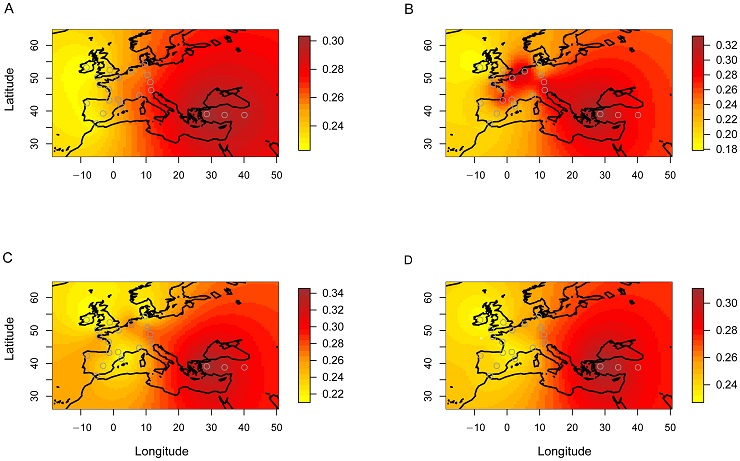Under favourable conditions skeletal remains that have been stored in the ground for millennia may still preserve the remnants of bone cells and together with them the deoxyribonucleic acid (DNA) carrying genetic information. The number of individuals from whose bones it has been possible to extract pre-Neolithic DNA and implement Neolithic dating has been increasing and together with that there is also the hope that answers will be found regarding the question of the genetic contribution of the Near Eastern populations during the beginnings and the spreading of agriculture in Europe. The key to understanding both the processes and the contacts that took place at that time (although they were subsequently overlaid by newer ones) is, in the geographic context, also our individual genetic variability. Also contributing to the intensification of this debate is the growing volume of data available regarding the current genetic diversity of people.
 |
| This geographic model created on the basis of Y chromosome haplogroups R1b1b2 shows the spreading population waves of farmers from the Near East. According to Sjödin – François 2011. |
The first attempts to apply genetic data to solving archaeological issues were implemented by P. Menozzi and his collaborators. As early as in the 1970’s he was already evaluating the frequency of specific forms of genes (alleles) of blood groups, the HLA-system and certain enzymes of the present population of Europe. He was also observing the frequency of proteins the structure of which is genetically encoded. These classic genetic markers were later also analysed by A. Ammerman and L. Cavalli-Sforza, who were using multidimensional statistical techniques. The beginnings of the European Neolithic should accordingly have taken the form of a fast-spreading and simultaneously rapidly growing population wave of agriculturists from the Near East. Although the model of demic diffusion is still supported by some scholars, the shift from the conventional markers to the direct analysis of DNA in the 1990’s also brought about strong arguments for scenarios of an entirely different kind. The first results of the analysis of mitochondrial (mt) DNA showed that the ancestors of most of the European populations arrived in Europe during the Upper Palaeolithic and that currently the Neolithic haplogroups are in the minority.
The mixed origin of the inhabitants of today’s Europe is demonstrated de facto by all types of studies – both those that investigated the classical markers and those that took into account the mtDNA haplogroups and Y chromosome. Also obvious is a form of migration corridor running from the southeast towards the northwest of the continent, but so far there is little general agreement regarding the size of the contribution of the indigenous and the Near Eastern groups. The genetic structure of Europe is quite complicated and the importance of the Near Eastern component varies in the different regions. It seems, however, that circulating in the veins of Europeans is a hearty portion of the blood of the hunter-gatherers. The mtDNA analysis showed that only about a fifth of the current population carries the line from the Near East and the remaining part is attributable to the direct descendants of migrations that took place long before the Neolithic period.
The studies that focused on the male Y chromosome also confirmed the dominant status of the haplogroups which can be defined as being Palaeolithic (R1a, R1b and I, in the Czech Republic in a total of 80% of men). It cannot be ruled out that probably some of the “Palaeolithic” haplogroups entered Central Europe during the Neolithic expansion - or possibly even later. The frequency of haplogroups following the Neolithic expansion (E3B, G and J2) decreases in the direction of the advancing migration wave and their share is in total 15% in the Czech lands. The remaining 4% of the Czech population derives its origins from the more recent migration events. The results of these studies are in agreement with the demographic models that estimate the fertility rates and the population growth rate of the first farmers. In accordance with demographic simulations fast spreading farmers were in the minority, while the local hunter-gatherers comprised 55-72%.
Want to learn more?
- Ammerman, A., and L. L. Cavalli-Sforza. 1984. The neolithic transition and the genetics of population in Europe. Princeton: Princeton University Press.
- Divišová, M. 2012. Current Knowledge of the Neolithisation Process: a Central European Perspective. Interdisciplinaria archaeologica. Natural Sciences in Archaeology 3 (1):141-153.
- Sjödin, P., and O. François. 2011. Wave-of-Advance Models of the Diffusion of the Y Chromosome Haplogroup R1b1b2 in Europe. PLoS ONE 6(6): e21592. doi: 10.1371/journal.pone.0021592.
 Archeologické 3D virtuální muzeum
Archeologické 3D virtuální muzeum

.png)